SUPER HEROIC PROPORTIONS
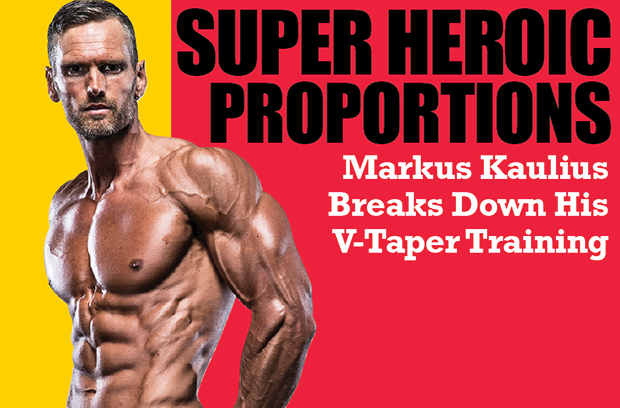
Markus Kaulius Breaks Down His V-Taper Training
Every little boy and girl grows up idolizing superheroes. Whether you love Batman because he’s a mortal with badass body armour, or Superman because he’s, well, Superman, or even Storm because controlling Mother Nature is the coolest thing ever, there’s some superhero out there for you. Even if you don’t have a favourite, there’s no denying that at some point or another, we’ve all thought about what super power we would want. Superheroes don’t just have the whole super power thing going for them; they’re also physically built to stand out. According to John Romaniello, one of the foremost strength and conditioning coaches, “We view certain physical traits as desirable in members of each sex: a V-shaped upper half of a man’s physique implies virility and strength. In fact, artists and sculptors have known about the golden ratio (1.618) for a long time and have used it to create sculptures and artwork of the ideal human figure. Even plastic surgeons and dental surgeons use it to restructure the human face.” The Golden Ratio refers to a number of different proportions between body parts, but the relevant one in this case is shoulder to waist; that’s what creates the “V look.” Broad shoulders and a thick chest, which taper into a tiny waist, define that V-taper. It’s the gold-standard ideal for most bodybuilders and fitness models.
Our gold standard for this article is Markus Kaulius, the President of Magnum
Nutraceuticals. He fits into the bodybuilder/fitness model/superhero category. This guy has the wide, rounded shoulders, big chest, a chiseled six-pack, and a barn-door back tapering down to a tiny waist.
But how did he get it all? How has he managed to be so successful in business and in the gym? How does he keep himself so lean and run a multimillion-dollar company by day and fight crime by night? (Note: He doesn’t actually fight crime. He spends time with his wife and two daughters.) We sat down with this modern-day Superman to find out how he built his exceptional V-taper.
 INTERVIEW
INTERVIEW
MUSCLE INSIDER: How many photo shoots have you done this year (2016)?
MARKUS KAULIUS: Probably 30. I have three photographers on staff here, and we do mini shoots once in a while too. In the last week, I’ve done six photo shoots. They’re a good 45 minutes to an hour. My thought process is that, (1) it’s great practice for them, (2) it’s good practice for me, (3) I’m in great shape, so why not take as many photos as we possibly can? Social media is using these photos all the time, so we just need these kind of photos.
MI: How have you managed to peak so perfectly for each one?
MK: Without sounding insulting, when you’re in really good shape and healthy (and also not cutting your water), there’s no rebound or risk of rebound. The very next day, I can do another major photo shoot for hours, and be arguably just as tight. The only way you can do that is when you come in very healthy. The competitors who have fallen into the trap of not being able to peak two weekends in a row, 99 out of 100 times, they may have done something unhealthy. This is just who I am—it’s a lifestyle. I love training and being able to shoot at the drop of a hat.
MI: What was it like mentally and physically having to go through that many peak weeks and keeping your body fat that low for so long?
MK: This is by far the best mental state I’ve ever been in, which had a lot to do with how little stress I’ve had at Magnum. This year, I had way better focus with work, JJ, my coach, was just instrumental in always monitoring me and my well-being, and then using a food prep company. Not having to prep my own food or worry about it—just eating what was provided—was a huge game-changer for me.
MI: When did you realize you wanted to build the superhero-type physique, as opposed to just going for being lean or strong?
MK: I’m working with the physique God has given me. I’m a tall dude at 6'6", and I don’t think I’m built for strength. I’m not a strong guy. I know a lot of that is mental, but I also do believe that people who are this tall generally aren’t the strength guys. The improvements I’ve made are just what come naturally; it’s the body I was designed to have.
MI: Approximately how many calories do you do to maintain your current body fat?
MK: I think I’m eating about 3000 right now. Nothing really changes in terms of my nutrition when I’m peaking for a shoot; maybe I’m a touch lower. I may have been around 2600, and then the day of, I get to eat cheesecake! That works so well, only because I hadn’t had a cheat meal for four months. My body hadn’t seen simple sugars in four months, and it filled me right out and felt amazing.
MI: How much cardio do you do to stay that lean?
MK: Right now, I’m doing 45 minutes a day, five days a week. It’s about consistency and diet.

MARKUS ON THE IMPORTANCE OF FORGING SUPERHERO ARMS:
“I wouldn’t argue that arms are super important; shoulder, back, and chest are the keys to a great V. I train my arms once a week max, but of course they get worked with other exercises. For this month, I won’t do a full arm day—I’ll do a half arm day, and it’s mixed in with pecs. I feel like they’re strong enough as is, but also because they get enough work when I train chest and back.
For dumbbell curls, I never do the same dumbbell curl twice. I’m constantly varying up my curls: supinating, reverse, low pulleys, high pulleys, behind the head curls … I hit everything. I probably don’t do the same curl more than once every two to three months.”
EXERCISES
Seated Dumbbell Overhead Press
1) Grab dumbbells and sit on a bench that has a back support, then place the dumbbells on your thighs.
2) Clean/raise the dumbbells up by your shoulders.
3) Turn your wrists and elbows so that the palms of your hands are facing forward and slightly in.
4) Push the dumbbells up and together until they touch at the top.
5) Slowly bring them down back to the starting position.
Markus’ tip: “I like to focus on engaging my core and pressing my lower back heavily into the seat. That’s the big difference with me, because a lot of people really arch their back, and it’s working a totally different part of their body. That’s why I press my lower back into the seat, because it really gets the top heads of the shoulders.”

Dumbbell Lateral Raises
1) Grab dumbbells and stand upright with the dumbbells by your side, with the palms of your hands facing you.
2) Lift the dumbbells up until shoulder height, with your arms parallel to the floor and a slight bend in your elbow. Your hands should be tilted forward a little as if pouring water into a glass.
3) Lower the dumbbells back down slowly to the starting position.
Markus’ tip: “I superset just the top half of the movement for 15 reps, with 15 of the full movement. It’s very humbling, because you can start with 5s, and you’ll still be crying. I do these standing.”
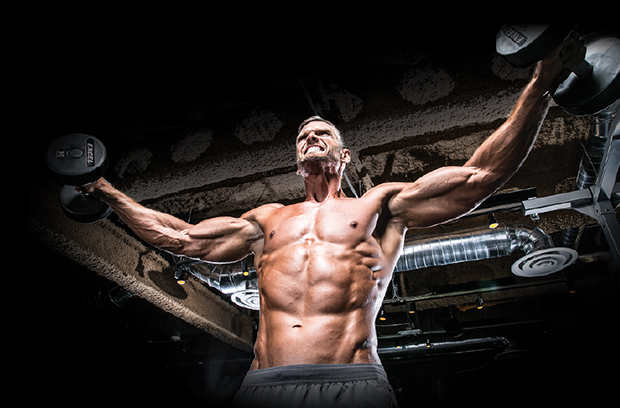
Pull-ups
1) Grab a pull-up bar using a wide grip with palms facing forward.
2) Pull yourself up by drawing the shoulders and upper arms down and back, until you’re high enough that your chin is just by the bar.
3) Concentrate on squeezing the back muscles, while keeping the shoulders and biceps contracted. The upper torso should remain stationary, and only the arms should move.
4) When done, start to slowly lower yourself back down to where your arms are fully extended and the lats are stretched.
Markus’ tip: “Keep your shoulders as far back as you can. I do wide grip, and I want to stay on a flat plane, almost like I’m on a machine going up and down. I also switch it up between doing parallel and underhand grip. The key is blowing out most of my air so that I engage my core and stiffen my lower body, which strengthens my core.”

Straight-Arm EZ-Bar Pull-Downs for Lats
1) Grab a wide bar or EZ bar from the top pulley of a cable stack, and grip it palm down slightly wider than shoulder-width. Your arms should be straight out in front of you (fully extended), and elbows slightly bent.
2) Bend your torso forward at the waist slightly with your arms in front of you, and tighten the lats.
3) While keeping the arms straight, push the bar down by squeezing your lats until your hands are on top of your thighs.
4) Let the bar come back up slowly until your arms are parallel with the floor.
Markus’ tip: “The key to this one is blowing out most of your air to really engage your lower core. That will flare your lats more than anything because it’s pulled everything in, so as you’re going up and down, you’re hitting the lats better than normal.”

One-Arm Bent-Over Dumbbell Rows
1) Pick a suitable weight with a dumbbell, and set it down by your feet near the dumbbell rack.
2) Brace yourself against the rack with your right arm, using it to keep yourself stable. Bend slightly at the waist, keep your core tight, and keep your spine neutral.
3) Use the left hand to pick up the dumbbell on the floor and hold the weight while keeping your lower back straight. The palm of the hand should be facing your torso.
4) Pull the weight up to the side of your chest, keeping your upper arm close to your side and torso stationary.
5) Switch sides and repeat with the other arm.
Markus’ tip: “Two key things for me here: First is a big reach on the down motion. I’m
really trying to get a big stretch with a straight arm. I also try to reach forward as opposed to just down, like I’m trying to start a lawn mower. And then the second part is in contracting, I’m trying to rub my elbow across my body, so it’s super tight and not flaring out.”
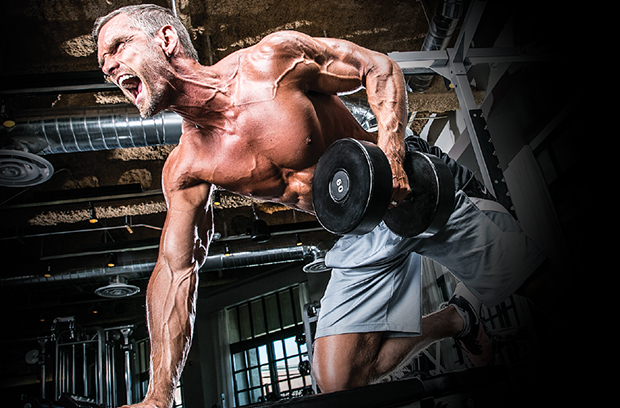
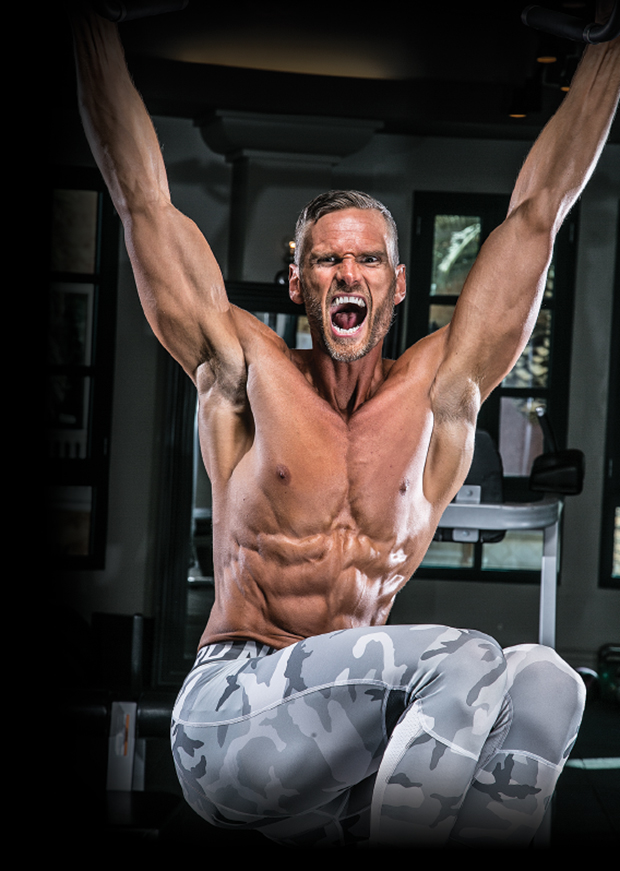 Hanging Twisting Leg Raises
Hanging Twisting Leg Raises
1) Grab pull-ups bars using an overhand grip, then hang there with your legs extended and body straight.
2) Flex your hips and knees, bringing your knees up into one side, raising them above 90 degrees at the hip.
3) Don’t swing. Perform the exercise with control.
4) Return to the starting position and then perform the movement to the other side.
Markus’ tip: “When you’re flexing and engaging properly, it should hurt your ribs. I engage so hard and blow out so much air, that when I bring my knees up, it almost feels like my ribs are being collapsed on top of each other. That’s when I know I’m doing it right.”
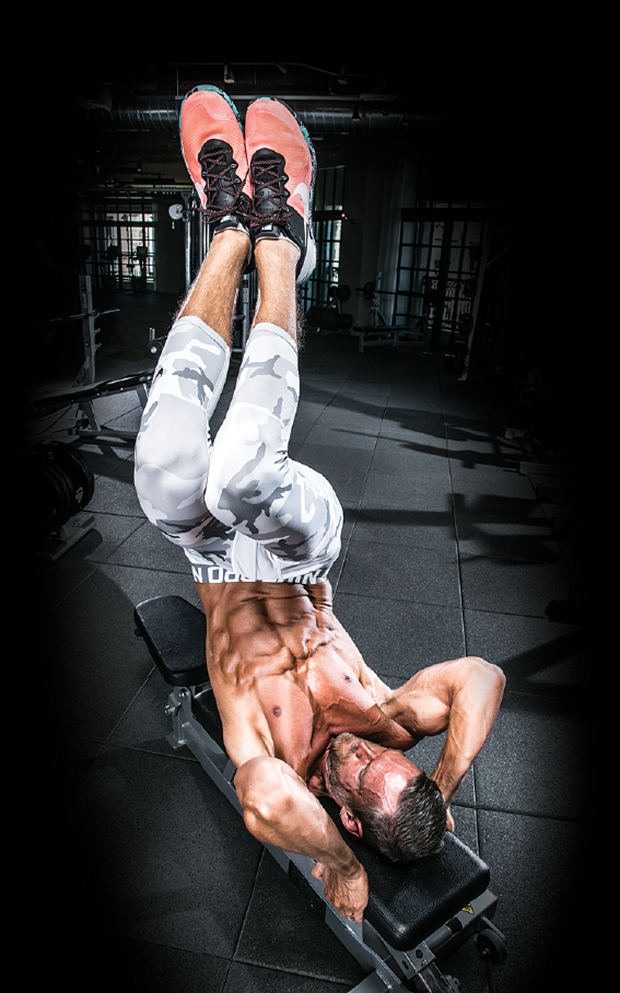 Lithuanian Corkscrew
Lithuanian Corkscrew
1) Leg lift to the left: Lying on your back on a flat bench, keeping legs flat and straight, your feet go straight up in the air and your core twists to the left. End with your shoulder blades on bench and your feet way up and pointing to the left. Come down to touch your bum to bench, continuing to contract and squeeze abs, then right back up. Repeat 15 times.
2) Switch to the right leg and repeat 15 times.
3) The Punisher. With knees together and bent and your bum off bench, twist left, then right as far as you can rotate. Repeat this fifteen times per side.
Warning: The Lithuanian Corkscrew, when done correctly, will require you to roll out of bed in the morning. It’s painful!
Markus’ tip: “Never for a second let your core relax. In keeping your core tense, you’re protecting your lower back. The minute you let go in that exercise, you risk potentially hurting your back. If you’re tightening properly, then by the time you actually get to doing reps, your core should already really hurt. For the part with the knees going back and forth, it’s critical that you don’t throw your knees further than where you can keep your core engaged.”
Go to Facebook or Instagram and type in #lithuaniancorkscrew to watch Markus perform this.
Photos by Alex Ardenti

